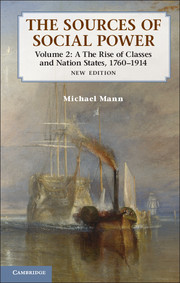Book contents
- Frontmatter
- Contents
- Preface to the new edition
- Preface
- 1 Introduction
- 2 Economic and ideological power relations
- 3 A theory of the modern state
- 4 The Industrial Revolution and old regime liberalism in Britain, 1760–1880
- 5 The American Revolution and the institutionalization of confederal capitalist liberalism
- 6 The French Revolution and the bourgeois nation
- 7 Conclusion to Chapters 4–6: The emergence of classes and nations
- 8 Geopolitics and international capitalism
- 9 Struggle over Germany: I. Prussia and authoritarian national capitalism
- 10 Struggle over Germany: II. Austria and confederal representation
- 11 The rise of the modern state: I. Quantitative data
- 12 The rise of the modern state: II. The autonomy of military power
- 13 The rise of the modern state: III. Bureaucratization
- 14 The rise of the modern state: IV. The expansion of civilian scope
- 15 The resistible rise of the British working class, 1815–1880
- 16 The middle-class nation
- 17 Class struggle in the Second Industrial Revolution, 1880–1914: I. Great Britain
- 18 Class struggle in the Second Industrial Revolution, 1880–1914: II. Comparative analysis of working-class movements
- 19 Class struggle in the Second Industrial Revolution, 1880–1914: III. The peasantry
- 20 Theoretical conclusions: Classes, states, nations, and the sources of social power
- 21 Empirical culmination – over the top: Geopolitics, class struggle, and World War I
- Appendix: Additional tables on state finances and state employment
- Index
- References
18 - Class struggle in the Second Industrial Revolution, 1880–1914: II. Comparative analysis of working-class movements
Published online by Cambridge University Press: 05 July 2013
- Frontmatter
- Contents
- Preface to the new edition
- Preface
- 1 Introduction
- 2 Economic and ideological power relations
- 3 A theory of the modern state
- 4 The Industrial Revolution and old regime liberalism in Britain, 1760–1880
- 5 The American Revolution and the institutionalization of confederal capitalist liberalism
- 6 The French Revolution and the bourgeois nation
- 7 Conclusion to Chapters 4–6: The emergence of classes and nations
- 8 Geopolitics and international capitalism
- 9 Struggle over Germany: I. Prussia and authoritarian national capitalism
- 10 Struggle over Germany: II. Austria and confederal representation
- 11 The rise of the modern state: I. Quantitative data
- 12 The rise of the modern state: II. The autonomy of military power
- 13 The rise of the modern state: III. Bureaucratization
- 14 The rise of the modern state: IV. The expansion of civilian scope
- 15 The resistible rise of the British working class, 1815–1880
- 16 The middle-class nation
- 17 Class struggle in the Second Industrial Revolution, 1880–1914: I. Great Britain
- 18 Class struggle in the Second Industrial Revolution, 1880–1914: II. Comparative analysis of working-class movements
- 19 Class struggle in the Second Industrial Revolution, 1880–1914: III. The peasantry
- 20 Theoretical conclusions: Classes, states, nations, and the sources of social power
- 21 Empirical culmination – over the top: Geopolitics, class struggle, and World War I
- Appendix: Additional tables on state finances and state employment
- Index
- References
Summary
Theory
The Second Industrial Revolution brought nationally integrated economies, stiffer international competition, and commercialization of agriculture throughout the West. To each country it brought capital concentration, industrial science, expansion of the metallurgical and chemical industries, of mining, and of transport, and the corporation. In every country this greatly expanded and massified the urban-industrial labor force and led to employer pressure on wages, hours, and the de-skilling of artisans. This economic revolution was astonishingly similar in all countries, and workers responded with similar, though ambiguous, collective organizations.
This chapter charts the resulting conflict between capitalists and workers in several countries. It focuses on explaining the curious outcome that such marked economic similarities among countries generated varied worker ideologies – all six types distinguished in Chapter 15 – and varied outcomes of industrial class struggles. Russia was on the road toward revolution; Germany seemed on a different, quasirevolutionary road; Britain was embarking on a mildly mutualist road; the United States, on a sectionalism largely devoid of socialism; and France still hotly debated all six options. Chapter 19 charts the similarly varied struggles in agriculture during the period. Both use a comparative method, taking national states as independent cases. I leave aside noncomparative aspects of labor movements – interactions among transnational, national, and nationalist organizations – until Chapter 21.1 explain class conflicts in this period in terms of interaction between essentially similar industrial and agrarian economies with the variety provided primarily by political crystallizations and to a lesser extent by the structure of working-class communities.
- Type
- Chapter
- Information
- The Sources of Social Power , pp. 628 - 691Publisher: Cambridge University PressPrint publication year: 2012



